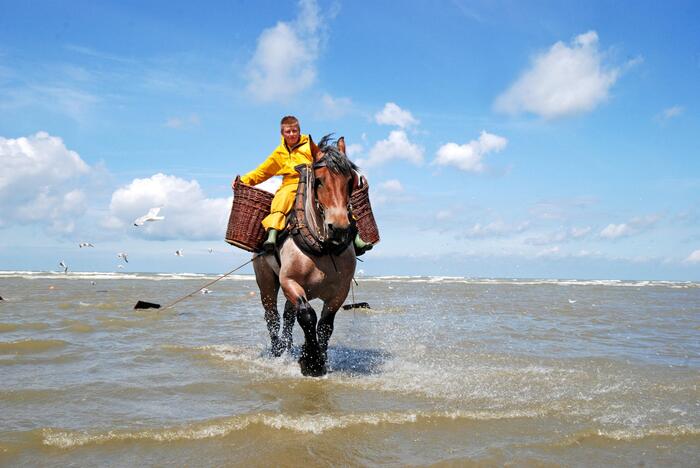OOSTDUINKERKE (Koksijde) - Oostduinkerke, a small hamlet of Koksijde, along the western coast of Belgium overlooking the North Sea, boasts an original record: it is the only place in the world where shrimp are fished on horseback.
The tradition, which UNESCO has included in the list of the intangible cultural heritage of humanity, dates back to the Middle Ages and since then the only innovation has been the introduction of denser and more resistant networks.
Once this type of fishing, with the trawl net (seynevissen) pulled by horses and carriages, was widespread along the entire North Sea coast, from France to Belgium up to Holland and southern England, but it only survived in Oostduinkerke, Flanders, 20 kilometers from Ostend;
here both the small and delicious gray prawns and the fishermen who pass down the fishing tradition from generation to generation are constantly increasing.
The unusual practice takes place twice a week in the months between June and September: at 8 in the morning, when the beach lengthens thanks to the low tide, the draft horses, mostly of the Brabant breed, are brought to the shoreline, where the fishermen (paardenvissers) prepare long triangular nets for shrimp fishing, which are collected in large wicker baskets located on the sides of the saddles.
The horses are made to enter the water up to their bellies, while the fishermen wearing long oilskins and rubber boots get out of the carriages and begin to slowly sift through the bottom to catch the gray shrimps (rikzegarnalen), which hide under the sand.
Fishing lasts about two hours, until high tide arrives which brings the fisherman and horse back off the beach.
The delicious gray prawns, also called "North Sea caviar", are the main ingredient of many typical Flanders dishes, including croquettes, an exquisite batter that envelops prawns and melted cheese, and tomate-crevettes, tomatoes stuffed with prawns and pink sauce.
Often the daily catch is cooked on the beach and sold in white paper boxes for a few euros;
the ideal, however, is to taste these specialties in the nearby restaurants.
For more information and to see the fishermen at work: www.visitflanders.com/it and https://oostduinkerke.com/en/event/239/shrimp-fishermen-on-horseback.html
Reproduction reserved © Copyright ANSA

